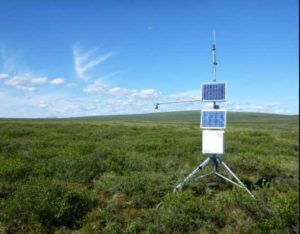
More areas of year-round unfrozen ground have begun dotting Interior and Northwest Alaska and will continue to increase in extent due to climate change, according to new research by University of Alaska Fairbanks Geophysical Institute scientists.
The scientists said the spread of taliks — volumes of unfrozen ground within areas of permafrost — has major implications for the movement of carbon among organisms, minerals and the atmosphere. Taliks will also affect the transfer in water of material such as nutrients and increase development of thermokarsts, areas of sunken land formed by the thawing of permafrost.
Their findings were reported today in the journal Nature Geoscience.
Louise Farquharson, a research assistant professor, authored the paper. Geophysics Professor Emeritus Vladimir Romanovsky, research assistant professor Alexander Kholodov and research associate professor Dmitry Nicolsky are co-authors. All four are with the Geophysical Institute’s Permafrost Laboratory. Romanovsky, Kholodov and Nicolsky are also affiliated with institutions in Russia.
“We’re in a transition phase where we commonly see talik formation but also can see them refreeze if we have a year with low snow and very cold winter temperatures or a cool summer,” Farquharson said. “After approximately 2030, however, our air temperatures in the summer and winter will warm up enough that we’re going to have talik formation no matter what the snow does.”
“I think it’s important for people to know that what we have seen so far with permafrost degradation in Fairbanks, for example, is not a steady state,” she said. “The rate and extent of permafrost degradation is probably going to accelerate as talik development really kicks in.”
Taliks can occur at a variety of locations: between the top of the permafrost and the bottom of the seasonally frozen layer, within the permafrost due to water flow and within the permafrost due to previous thaw events, such as after a lake has drained. They can also cut through the whole permafrost column where permafrost is thin, often due to the presence of rivers or lakes.
More taliks will form in a wider area of Alaska as summer and winter temperatures increase and the depth of summer ground thaw begins to exceed the depth of winter freeze.
Consequences can include, for example, the new water’s movement of material previously locked in frozen ground. Dissolved organic carbon, dissolved nitrogen and contaminants such as mercury could eventually find their way into streams and rivers.
A spreading degradation of permafrost will also create challenges for new construction and maintenance of existing buildings and other infrastructure.
The scientists analyzed ground temperature data from 1999 to 2020 collected at dozens of Alaska sites in the Permafrost Laboratory monitoring network. They then selected 54 of those sites for study, encompassing an area of approximately 116,000 square miles.
Of the 54, scientists observed incomplete freezing and the early stages of talik formation at 24 sites in the winter of 2017-2018, up from three the previous year.
In the past, taliks were primarily associated with rivers and thaw lakes and in areas affected by wildfires, which remove thermally protective vegetation and therefore allow for deeper summer thaw. None of the sites studied by the UAF team had been affected by disturbances such as surface water bodies or wildfire.
Talik formation in the study area accelerated in earnest in 2017-2018 due to higher air temperature and above average snowfall, the scientists found. Because of its insulating properties, heavy snow slows the transfer of heat from the ground to the atmosphere, thereby lengthening the amount of time needed for the ground to refreeze and, in some cases, preventing a complete refreeze.
The research team’s modeling and observations show that talik formation at the study sites occurred only briefly in the 50 to 60 years prior to 2017-2018.
The team also writes that current assessments and projections about permafrost thaw are underestimating the extent of the thaw because they do not include the impact of widespread talik formation.
The researchers projected that, under the high emissions scenario of the International Panel on Climate Change, talik formation by 2030 will have begun across up to 70% of the discontinuous permafrost zone, regardless of snow conditions. By 2090 talik thickness in areas of black spruce forest and warmer ecosystems may reach 40 feet.
“Our climate trajectory is likely going to make talik formation an important driver of permafrost degradation in the discontinuous permafrost zone and eventually, as temperatures continue to warm, in the continuous permafrost zone further north,” Farquharson said. “And not only in Alaska but also in other Arctic regions.”
“Talik formation is going to become a really important mechanism of permafrost degradation,” she said.
The National Science Foundation, the U.S. Department of Energy and Tomsk State University in Russia funded the research.
Source: Geophysical Institute
